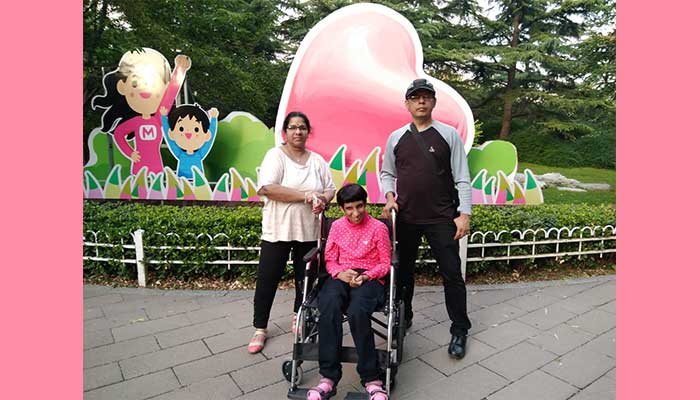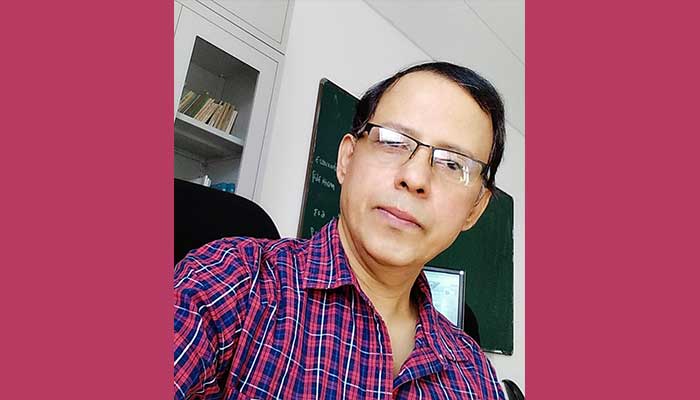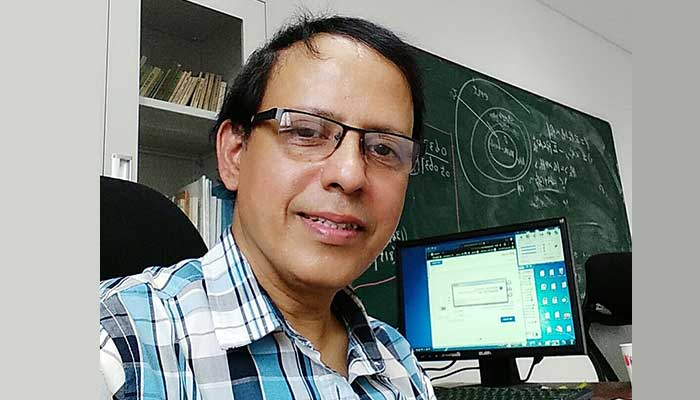Top Indian physicist and Head of IIITH’s Center for Quantum Science and Technology (CQST), Prof. Arun Kumar Pati features among the world’s visionaries who are driving research in the foundations of quantum mechanics, quantum information and quantum computers.
Google the key words ‘World Famous Quantum Information Scientists‘ and you will find Dr. Arun Pati’s name pop up at the top of that list. “ It’s an amazing feeling” says the researcher whom Stanford University ranked as among the top 2% scientists (2020) in his domain.
It has been a long journey spanning over three decades for the Quantum theoretical physicist who began working in the field in the 1990s, when the concept was still a pipedream. “At that time, no one was working on these topics in India and I had to design my own research problems!”, he chuckles. His early investigations to understand quantum information would lead to several no-go theorems that would set the rules for quantum computing and quantum information processing devices.
Building the future of Quantum communication
“Quantum information is essentially a field where you study how the concepts in classical information systems can be carried over to quantum systems”, he explains. “Our studies prove that certain operations in classical information processing devices cannot be carried over to quantum information processing devices”. For instance, in the quantum world, it is not possible to design a Xerox machine. This was the first No-Theorem in quantum information that has significant positive implications in quantum communication and security.
In 1999, Arun and his team would make a major discovery in quantum information Science. It was the remote state preparation (RSP) protocol, similar to quantum teleportation, where an object is destroyed at the source location and recreated at the destination, something seen in Sci-fi movies so far. “This is now possible” observes the professor whose work in RSP protocol has been experimentally tested by several groups. He was honored with the Indian Physical Society Award for Young Physicist by Indian Association of Science, Kolkata (1996) and Indian Physics Association Award for Young Scientist (2000) for his pioneering work in the field.
The physicist has collaborated with the international scientific community; with Artur Ekert, Vlatko Vedral et al, and introduced the concept of geometric phase for mixed states. With L. Maccone, he would discover stronger uncertainty relations that capture the notion of incompatible observables and demonstrate that quantum world is more uncertain than what Heisenberg-Robertson’s uncertainty relation expounded.
IIITH is nurturing an ecosystem for a quantum leap
Cited among the top research institutes in Quantum computing by Analytics India, IIITH’s CQST and Arun Pati’s current research is in the realm of quantum coherence and entanglement in Quantum Computing, Quantum Communication, Quantum Thermodynamics, new method of Quantum State Determination (Quantum State Interferography) and Quantum Measurement.
He brings over three decades of pioneering expertise in theoretical physics from his stints at Allahabad’s Harish Chandra Research Institute and Bhabha Atomic Research Centre, Mumbai. “I have been visiting IIITH as adjunct professor for over 3 years. It is a really happening place with a lot of activity and enterprise”, admits the scientist who enjoys working in IIITH’s engaging environment. “In India, there are small groups and few researchers in this area and we at CQST are one of the largest groups working on this. My main aspiration is to make the Center visible, not only on the national scene but once we overcome our teething problems, we should be an international player and leader in the next 5 years and support startup companies”, prophesizes the physicist who holds the Number 1 position in the global list of famous quantum information scientists.
The young lad from Aska – Origin story
The young physicist’s early childhood and education was in a remote Odiya town called Aska in Ganjam district where his father worked in the veterinary department. After completing his schooling at Harihara High School (1981), the youngster with a hyperactive imagination would conjure up visions of becoming a poet, painter, actor, lyricist or novelist. “I had all kind of crazy ideas in my youthful days. I read a lot of Odiya poets, was really influenced by the film world and dreamt of becoming a film actor, director or something on those lines”.

From dabbling in watercolour, pencil sketches and oil paintings in his early years, his creative pursuits these days are penning the occasional romantic song, poems and the 30-minute yoga session. “I enjoy the simple things in life. I spend time with my family – wife Rashmi, our daughter Arshia, a special child who needs lots of support and son Anwesh, an engineer employed in a private firm”.

Young scientist who started out by trying to disprove quantum world
There’s a funny story linked to his initial interest in quantum mechanics. The turning point was during his B.Sc in Physics at Aska Science College (1983–1985) when he first considered becoming a scientist. What mystified the B.Sc student was the descriptions of subatomic particles in quantum mechanics that was wildly different from known definitions in the classical world. “On top of that, we are told that a single entity behaves like a wave and a particle! I thought there might be something wrong with the rules of quantum mechanics. I got into quantum mechanics with the intention of discrediting the theory and along the way, I fell in love with the subject”, says Arun. He would successfully complete his Master’s degree in physics from Berhampur University (1987) and later would be feted with the Distinguished Alumni Award in 2021.
BARCing up the right tree
To his delight, young Arun Pati would be selected to work at BARC, Mumbai and after a training period, he would have a successful stint as scientific officer (1989-98). When he joined BARC, nobody was interested in quantum mechanics “because the focus was on productive research in nuclear energy. At that time there was essentially no one to guide me. I would go to the library to scour through journals or find someone to discuss the research problem. I gradually began to realize that the future would be in quantum computing. This was in 1989 and I published my first paper in 1991”, he reports. Concurrently, he would pursue his Ph.D from the University of Mumbai (1994-98), by which time he had already published 16 papers. Due to lack of faculty guides, friends like Sudhir Jain, Harish Parab and Abhas Mitra would be a sounding board for his ideas. “I published my own research papers but needed to find someone to sign my PhD Thesis as a guide”, chuckles the self-made researcher.
A jet-setting career awaits the physicist
In 1998, he would have an eventful two-year tenure as EPSRC (Engineering and Physical Sciences Research Council) Fellow and visiting scientist at Bangor University, Wales.
Along with Samuel L. Braunstein, Dr. Arun’s research into quantum information led to the no-go theorems in quantum information such as the no-deletion theorem and the no-hiding theorem . Later, he also proved the no partial erasure theorem and very recently the no-masking theorem. These theorems are fundamental results that differentiates quantum information from classical information. It is like setting the rules that Quantum computing and Quantum Information processing devices must respect. The no-deleting theorem can be found in many national and international newspapers.
The physicist has authored more than 150 research papers in international journals and conferences and has been actively involved in organizing conferences and workshop on quantum information like ISCQI-2008, IPQI-2010, QIPA-2011 and IWQI-2012. He has contributed chapters to two books – ‘Quantum Information with Continuous Variables’ published by Springer and Quantum Aspects of Life – coauthored by Derek Abbott, Paul C. W. Davies and Arun K. Pati, with a foreword by Sir Roger Penrose. In 2009, he was awarded the Samanta Chandrasekhara Award by Odisha Science Academy, for original and creative contributions in Quantum Information.
During his decade long association with the Harish Chandra Research Institute (2011 – 2022), he was also juggling roles as K. P. Chair Professorship at Zhejiang University, Hangzhou, China (2013–2015), Adjunct professor at IISER, Mohali and visiting faculty at the Institute of Physics, Bhubaneswar (2001-2010).
In 2013, he had the double honor of being elected as a Fellow of the Indian Academy of Science, Bangalore and the National Academy of Science, Allahabad. He was awarded the DST-issued J C Bose National Fellowship in 2019. From 2021, he is a founding director of Quantum Ecosystem and Technology Council of India (QETCI), a successful Hyderabad-based entity. He is also the National Coordinator for DST’s Quantum Enabled Science and Technology (QUEST) program; presently in the first phase of the National Quantum Mission .

What next?
“While our research in quantum computing is to design a new class of powerful computers which will complete tasks very fast, compared to even a supercomputer, we are also looking into quantum communication, quantum sensing, quantum cryptography among others. The exciting field of Quantum Information Technology will have real world applications in areas like healthcare, transport, weather prediction and finance. Since quantum communication channels are very secure and cannot be duplicated, it will be invaluable for defense, banking etc. Governments and multinational corporations like IBM, Google, Microsoft etc are already investing billions to build quantum computers. The future promises to be most exciting and as a scientist, I look forward to new ideas, new predictions and our Center leading the way”, concludes the quantum theorist.



Good Read Deepa.
Pushp Sirohi says:Excellent interpretation of an Indian Scientist as a real creative man. It is really Worth reading .Thanks a lot.
Goutam kr. Biswas says:Thanks for this information.
Ajay Tiwary says: